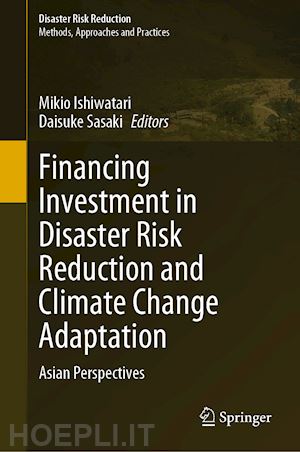
Questo prodotto usufruisce delle SPEDIZIONI GRATIS
selezionando l'opzione Corriere Veloce in fase di ordine.
Pagabile anche con Carta della cultura giovani e del merito, 18App Bonus Cultura e Carta del Docente
Financing Investment in Disaster Risk Reduction and Climate Change Adaptation: Opportunities and Challenges.- Financing in Climate Change Adaptation.- Recent Trends in Disaster Risk Reduction Investments: A Literature Review.- Exploring people's perception of disaster risk reduction investment for flood management: the case of Jakarta floods in Indonesia.- Factors influencing climate change adaptation investment by local government units in the Philippines.- Financing Infrastructure of DRR: Possibility of integrating investments in maintenance and DRR.- Financing Climate-Resilient Coasts: Tracking Multilateral Aid for Ocean and Coastal Adaptation to Climate Change in Asia-Pacific.- Early Recovery in Humanitarian Response: In the Cases of Four Disasters in the Asia-Pacific Region.- Is the Post Disaster Needs Assessment Important to Investment in Disaster Risk Reduction and Climate Change Adaptation? Lessons from Indonesia and the Philippines Based on Literature Review.- Estimating the Benefits of Flood Protection-Reviewing the Transition of the Cost–Benefit Analysis Manual in Japan and the Implementation Status of the International Flood Protection Project.- Nature-based solutions for river restoration in Japan.- Future Perspectives of Financing Investment in Disaster Risk Reduction and Climate Change Adaptation.
Dr. Mikio Ishiwatari is a senior advisor on disaster management and water resources management at the Japan International Cooperation Agency, and a visiting professor at the Graduate School of Frontier Sciences, The University of Tokyo. He has been engaged in projects and research work on disaster risk reduction, climate change adaptation, and water issues. He led the formulation of the Japanese assistance policies of climate change adaptation and community-based disaster management.
At the World Bank he worked as a senior disaster risk management specialist and published Learning from Megadisaster: Lessons from the Great East Japan Earthquake. He worked in various positions at the Ministry of Land, Infrastructure, and Transport, Japan, for 17 years, and was responsible for research and technology development as a senior deputy director for river technology and information. He also worked as an urban development specialist at the Asian Development Bank. He holdsa Ph.D. in international studies and an M.Sc. in urban engineering from The University of Tokyo.
Dr. Daisuke Sasaki is an associate professor of the International Research Institute of Disaster Science (IRIDeS) at Tohoku University in Sendai, Japan. He holds a Ph.D. (2015) in international studies and also has expertise in disaster science.He has been continuously conducting research focusing on the factors that might hinder the resolution of regional issues from the perspective of international cooperation both qualitatively and quantitatively, and also engaged in plenty of international collaborative research with several universities in the Asia-Pacific region.
Dr. Sasaki has published a number of articles in refereed journals including the International Journal of Disaster Risk Reduction (IJDRR), and he has served as a guest editor for several special issues of the Journal of Disaster Research (JDR).











Il sito utilizza cookie ed altri strumenti di tracciamento che raccolgono informazioni dal dispositivo dell’utente. Oltre ai cookie tecnici ed analitici aggregati, strettamente necessari per il funzionamento di questo sito web, previo consenso dell’utente possono essere installati cookie di profilazione e marketing e cookie dei social media. Cliccando su “Accetto tutti i cookie” saranno attivate tutte le categorie di cookie. Per accettare solo deterninate categorie di cookie, cliccare invece su “Impostazioni cookie”. Chiudendo il banner o continuando a navigare saranno installati solo cookie tecnici. Per maggiori dettagli, consultare la Cookie Policy.